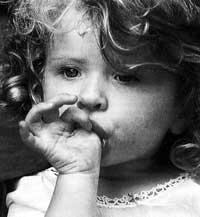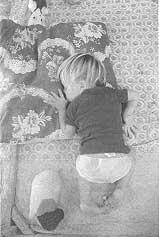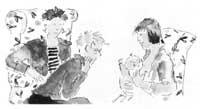Diarrheas
1994/06/01 Agirre, Jabier - Medikua eta OEEko kidea Iturria: Elhuyar aldizkaria
When the child, and especially the infant, hears diarrhea, does the doctor and the child's father value the same? My answer is negative and that is why I will try to define the picture ahead of everything.
What are diarrhea?
It is more important to define the definition of what is believed, since many times the fact that stools are more watery or softer than conventional stools can make parents worry without too much reason. Usually the stools of a child raised with breast have a creamy, slightly liquid appearance, while those fed with pharmacy milk are apparently more consistent.
Before the doctor says there are diarrhea, he or she will evaluate the consistency of the stool and the number of times the child has done it a day. There will also be no lack of any other characteristic of intestinal transtorno, such as abdominal pain, so the child can be nervous, crying and without appetite. Vomiting also appears quite often, which indicates that the stomach is also confused. It is a gastroenteritis that simultaneously affects the stomach and intestine. The picture can be more serious and the reasons are very different.
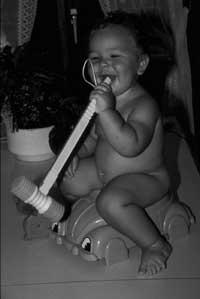
In the case of more curved children and adults, diarrhea is usually self-sufficient, but in infants should be considered as severe pictures due to the possible risk of dehydration.
What causes diarrhea?
As mentioned above, the causes of diarrhea can be many and very different, but the most frequent is the presence of some error or hancascarization in the diet (for example, food outside the usual), which will provoke an exaggeration. Normally these cases are usually light.
The cause of acute diarrhea on other occasions is unspecific inflammation of the gastrointestinal mucosa or inflammation with infectious cause. Of these, the most frequent are viruses (microorganisms of very small size). The viruses are resistant to antibiotics, so the therapeutic does not have a role in this regard. Bacterial infectious diarrhea are less frequent: they are more evident in symptomatology and depending on the characteristics of the picture, the symptoms and duration of the picture, the doctor will request a bacteriological culture of the feces (coproculture) to detect the presence of some germ. Once this has been checked, the pediatrician will prescribe the appropriate antibiotic treatment in those cases where it is necessary.
On fewer occasions diarrhea caused by intestinal check (for example, the musculature lamblia) are observed which, despite their rarity, provoke in the large hidden nurseries.
Infections outside the digestive system can also produce diarrhea. For this reason, as an example, do not be surprised that a child goes to the consultation for descending causes (with or without fever) and that the pediatric diagnosis is an otitis, that is, an inflammation of the middle ear or an infection of the posterior cavity of the eardrum membrane. This type of diarrhea is said to be parenteral, that is, originally produced outside the digestive system.
Diarrhea may be due to the administration of certain drugs or medications. Among these drugs, we must mention some antibiotics, since in addition to eliminating harmful germs, they destroy other beneficial germs that help digestion of food. In this way the intestinal ecosystem will be altered giving rise to a situation called desbacteriosis.
There are more strange causes, of which the doctor will think, once the most frequent are discarded.
And to finish clarifying things, you might have taken into account that this good reader I have referred so far to acute diarrhea. This denomination of acute is attributed to a duration less than fourteen days, usually the one that begins abruptly, being able to occur in some cases vomiting and fever. This type of diarrhea is the most common in children younger than three years.
What should be assessed in acute diarrhea?
Even if it is brief, it is advisable to inform the parents of a series of symptoms and signs that, in view of the severity of the situation and of the need or not for treatment by the pediatrician, will value better. The existence of fever and the amount, the sleep (especially if it is special and habitual), the lack of appetite (which can become total) are the data that the pediatrician will value in detail.
If the child takes breast, the medications the mother takes are also important. Also new foods that were recently introduced into the child's diet.
Other factors to take into account are contact with the person affected by a gastrointestinal infection, the coincidence of diarrhea with a trip, and the use of water other than that commonly used in feeding the child.
All these data are of great use to the pediatrician, as well as others that he can request in each case, to begin the treatment of the resolution of the table as soon as possible. The inadequate use of dry diets for too long, as well as the premature or unnecessary administration of medicines to the child, can convert a mild, acute diarrhea into a long-lasting diarrhea with all the adverse effects that it carries.
How to treat diarrhea?
Although not clear, the first gold law indicates that the administration of medicines, if necessary, is an exclusive work of the pediatrician. However, the mother has something to do before going to the doctor, if the picture starts abruptly and the stools are repeatedly soft.
The most serious complication of diarrhea is dehydration, loss of fluids, and the consequent loss of electrolytes (chlorine, sodium, potassium, etc.) that immediately affects the general condition of the child. Dehydration has been for many years the most frequent cause of hospitalisation of infants. Today, fortunately, this situation is much less seen in families thanks to education for health (and advice from pediatricians).
However, it is convenient for parents to know the first symptoms of dehydration and, if they appear, go immediately to the emergency department. But knowing how to prevent it is even more interesting. It has always been mentioned the sign of wrinkle or crease, which is said when the wrinkle acquired with fingers persists on the skin of the belly. But before that sign there is another one to know: the dryness of the mucous, which is manifested above all in the tongue of the child, which becomes more rough and rough when it is touched. In other words, dehydration is first touched and then seen.
There are different brands of dissolution in the market to rehydrate the baby by mouth. The pediatrician will always indicate what is most suitable for the child, as well as the amount of water to be used in each case and the amounts to be offered to the child.
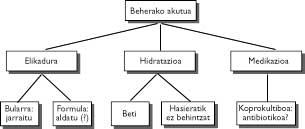
In addition to rehydration, and despite the importance of what is said, the main concern of parents is feeding. As in this paper it is not possible to quote and explain all possible cases, I will briefly summarize the main ideas.
- In the case of a child who only takes breast, it is advisable to continue breastfeeding, even though the most important sugar of milk can become malabsorbed during a season.
- In children who only take artificial milk, and attending to the severity of the table, some recommend unharmed milk for twenty-four hours to continue with traditional formula milk.
- There is still doubt that dry foods commonly used in the case of acute diarrhea, such as rice, carrot, apple, banana or lemon, have an exact degree of digestibility. However, its use for a period of time greater than five or eight days is an aspect to be assessed positively, since diarrhea has often elongated.
In any case, it has been clearly shown that in the case of diarrhea, the diet is continuous, or better said that a continuous diet is convenient, since it is the best way to avoid the nutritional risk and the ghost of dehydration.
Everything said should be considered as a general norm, since, as the proverb says, “there is no disease, but sick”, and therefore we must always individualize it, each case (that is, every child, every family, etc.) analyzing and adopting the necessary measures and recommending them (see diagram).

Gai honi buruzko eduki gehiago
Elhuyarrek garatutako teknologia




